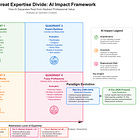AI & The Great Stratification of Work
As I’ve pointed out in AI & The Great Expertise Divide, AI amplification is not progressing linearly, but rather following power laws, only for a specific category of professionals. Are you in there?
By mapping professions along two ax…



